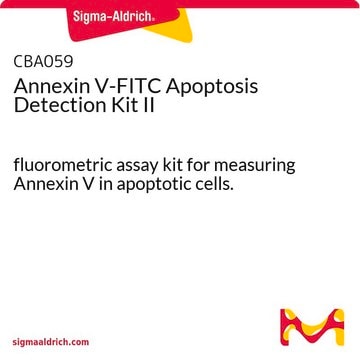Recommended Products
usage
sufficient for 60 cell suspensions
packaging
pkg of 1 kit
technique(s)
flow cytometry: suitable
application(s)
cell analysis
detection
detection method
fluorometric
shipped in
wet ice
storage temp.
2-8°C
Application
Features and Benefits
Packaging
Principle
Kit Components Only
- Br-dUTP 480 μL
- Fluorescein PRB-1 antibody 300 μL
- Negative control cells 5 mL
- PI/RNase staining buffer 30 mL
- Positive control cells 5 mL
- Reaction buffer .6 mL
- Rinsing buffer 120 mL
- Terminal deoxynucleotidyl transferase (TdT) 45 μL
- Wash buffer 120 mL
Signal Word
Danger
Hazard Statements
Precautionary Statements
Hazard Classifications
Carc. 1B - Eye Irrit. 2 - Flam. Liq. 2 - Resp. Sens. 1 - Skin Sens. 1
Storage Class Code
3 - Flammable liquids
Flash Point(F)
55.4 °F
Flash Point(C)
13 °C
Certificates of Analysis (COA)
Search for Certificates of Analysis (COA) by entering the products Lot/Batch Number. Lot and Batch Numbers can be found on a product’s label following the words ‘Lot’ or ‘Batch’.
Already Own This Product?
Find documentation for the products that you have recently purchased in the Document Library.
Customers Also Viewed
Articles
Cell based assays for cell proliferation (BrdU, MTT, WST1), cell viability and cytotoxicity experiments for applications in cancer, neuroscience and stem cell research.
Our team of scientists has experience in all areas of research including Life Science, Material Science, Chemical Synthesis, Chromatography, Analytical and many others.
Contact Technical Service










